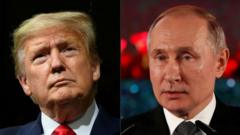Will Trump-Putin Peace Talks Fail and Trigger New Tariffs on India?

Understanding the Implications of US Tariffs on India: A Comprehensive Analysis
In recent times, the economic relationship between the United States and India has faced significant challenges. US Treasury Secretary Scott Bessent's warning about potentially increasing secondary tariffs on India has stirred discussions among policymakers and economists alike. This article delves into the implications of these tariffs, the underlying reasons for them, and the potential outcomes of the upcoming Trump-Putin meeting.
The Current State of US-India Trade Relations
Trade relations between the US and India have become increasingly complex, particularly in light of recent geopolitical events. Secretary Bessent's comments highlight a critical juncture in these relations, especially regarding India's growing imports of Russian oil. The US has already imposed a series of tariffs and penalties on Indian imports, reflecting the tension in the trade dynamics.
As per Bessent, the imposition of secondary tariffs on India is contingent upon the outcomes of President Trump's meeting with Russian President Vladimir Putin. This meeting, scheduled in Anchorage, Alaska, is pivotal for addressing the ongoing conflict between Russia and Ukraine, which has significant repercussions on global oil supply and international trade.
Understanding Secondary Tariffs
Secondary tariffs are additional tariffs imposed on a country that engages in trade with another country facing sanctions. In this context, India's imports of Russian oil have drawn the ire of the US, especially after the imposition of a 25% penalty tariff earlier this month. The rationale behind these tariffs is to pressure nations into compliance with US foreign policy, particularly regarding sanctions against Russia.
Impact of Russian Oil Imports on India-US Relations
The increase in India's imports of Russian crude oil from a mere 3% in 2021 to 35-40% in 2024 has raised eyebrows in Washington. This significant shift has strained diplomatic ties and complicated ongoing trade negotiations. India, as a major energy importer, argues that it must secure the cheapest available oil to protect its citizens from rising energy costs.
This situation poses a dilemma for India: balancing its energy needs while navigating the geopolitical landscape shaped by US sanctions. The ongoing conflict in Ukraine has heightened global oil prices, making cheaper Russian crude an attractive option for India. However, this has put India at odds with the US, which views these imports as a violation of its sanctions regime.
Trade Negotiations and Economic Consequences
Trade negotiations between Delhi and Washington have been ongoing for several months. Despite efforts to resolve tariff disputes, India's reluctance to reduce duties on agricultural and dairy products remains a significant sticking point. Experts have indicated that this impasse could hinder broader trade agreements and exacerbate tensions between the two nations.
Furthermore, the anticipated implementation of Trump's new 50% tariff rate on India, effective August 27, is seen as a severe escalation in trade hostilities. Analysts warn that such tariffs could effectively act as an embargo, stifling India's exports in crucial sectors like textiles and jewelry. The potential economic fallout could drag India's growth down by as much as half a percent, raising concerns over the broader implications for the Indian economy.
Geopolitical Considerations: The Trump-Putin Meeting
The upcoming meeting between President Trump and President Putin is steeped in global significance. The two leaders are set to discuss the ongoing war in Ukraine, a conflict that has ramifications beyond Europe. Bessent's comments suggest that the outcomes of this meeting could influence US sanctions and, by extension, the economic conditions for India.
Trump has emphasized the need for a unified approach towards Russia, urging European allies to join in imposing secondary sanctions. The effectiveness of these sanctions depends on the willingness of other countries to align with US foreign policy objectives. If the meeting yields no progress towards a peace deal, the likelihood of increased tariffs on India becomes more pronounced, potentially leading to further economic isolation.
India’s Response and Future Outlook
India's government has defended its position on Russian oil purchases, framing it as a necessary measure to protect its economy and its citizens. However, this stance may not be sustainable in the face of increasing external pressure from the US. The challenge for India lies in navigating these complex dynamics while seeking to maintain its energy security and economic growth.
The future of US-India trade relations hinges on a delicate balance between diplomacy and economic considerations. As both nations prepare for renewed negotiations, it is crucial for India to articulate its needs while also addressing US concerns about trade imbalances and compliance with sanctions.
Key Takeaways
- US Treasury Secretary Scott Bessent has signaled potential increases in secondary tariffs on India depending on the outcome of the Trump-Putin meeting.
- The US has already imposed significant tariffs on Indian imports, particularly concerning oil and weapons from Russia.
- India's rising imports of Russian oil have strained relations and complicated ongoing trade negotiations.
- Experts warn that increased tariffs could severely harm India's export-oriented industries and economic growth.
- The upcoming Trump-Putin meeting is pivotal for determining future sanctions and the trajectory of US-India trade relations.
FAQs About US Tariffs on India
What are secondary tariffs, and why are they imposed?
Secondary tariffs are imposed on countries that engage in trade with nations under US sanctions. They are intended to enforce compliance with US foreign policy and economic measures.
How have India's imports of Russian oil changed recently?
India's imports of Russian crude oil have surged from 3% in 2021 to between 35% and 40% in 2024 due to rising global oil prices and the need for affordable energy sources.
What are the potential economic impacts of increased tariffs on India?
Increased tariffs could significantly dampen India's export sectors, particularly textiles and jewelry, and may reduce economic growth by up to half a percent.
What role does the Trump-Putin meeting play in this situation?
The meeting is crucial as it may determine the future of US sanctions and tariffs, influencing the economic relationship between the US and India.
As the geopolitical landscape evolves, the interplay between economic policies and international relations will continue to shape the future of US-India trade. What strategies do you think India should adopt to navigate these challenges effectively? #USTariffs #IndiaUSRelations #Geopolitics
Published: 2025-08-14 09:45:26 | Category: world



